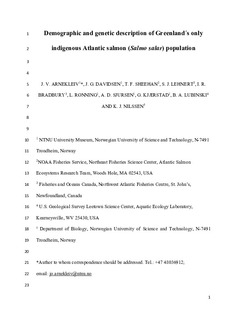| dc.contributor.author | Arnekleiv, Jo Vegar | |
| dc.contributor.author | Davidsen, Jan Grimsrud | |
| dc.contributor.author | Sheehan, T. F. | |
| dc.contributor.author | Lehnert, s.j. | |
| dc.contributor.author | Bradbury, I.R. | |
| dc.contributor.author | Rønning, Lars | |
| dc.contributor.author | Sjursen, Aslak Darre | |
| dc.contributor.author | Kjærstad, Gaute | |
| dc.contributor.author | Nilssen, Kjell J. | |
| dc.date.accessioned | 2019-02-21T08:11:06Z | |
| dc.date.available | 2019-02-21T08:11:06Z | |
| dc.date.created | 2018-11-29T11:41:47Z | |
| dc.date.issued | 2018 | |
| dc.identifier.issn | 0022-1112 | |
| dc.identifier.uri | http://hdl.handle.net/11250/2586628 | |
| dc.description.abstract | In Greenland, Atlantic salmon are known to reproduce in only one river, the Kapisillit River. Little is known about the population characteristics or the relationship to other salmon populations across the species range, and consequently, a survey of the system was conducted in 2005 and 2012. Juvenile salmon were captured in all stations surveyed within the lower river with the highest densities lower in the river and decreasing densities with increasing distance from the river mouth. Captured juveniles ranged from 0+ to 7+ years old and the predominant smolt age was between 4-6 years. Median length of 0+ and 1+ juveniles in August-September was 38.8 and 70.4 mm, respectively. The proportion of mature male parr increased from 4% for 1+ year old fish to 95% for fish greater than 2 years old. Genetic analysis using 96 single nucleotide polymorphisms (SNPs) revealed a high degree of genetic similarity between collections, extremely low genetic diversity, and low estimates of effective population size (Ne=28.7; 95% CI: 19.7-42.4). Genetic comparison to range-wide salmon populations demonstrated that the Kapisillit River salmon is an outgroup of the eastern Atlantic stock complex, which is consistent with the hypothesized colonization from the east. River morphology and the absence of glacier runoff are hypothesized to be the main reasons for the relatively high river temperatures supporting this self-sustaining population of Atlantic salmon. Given its uniqueness and persistence, this population represents an important part of range-wide biodiversity of Atlantic salmon. | nb_NO |
| dc.description.abstract | Demographic and genetic description of Greenland´s only indigenous Atlantic salmon (Salmo salar) population | nb_NO |
| dc.language.iso | eng | nb_NO |
| dc.publisher | Wiley | nb_NO |
| dc.title | Demographic and genetic description of Greenland´s only indigenous Atlantic salmon (Salmo salar) population | nb_NO |
| dc.title.alternative | Demographic and genetic description of Greenland´s only indigenous Atlantic salmon (Salmo salar) population | nb_NO |
| dc.type | Journal article | nb_NO |
| dc.type | Peer reviewed | nb_NO |
| dc.description.version | acceptedVersion | nb_NO |
| dc.source.journal | Journal of Fish Biology | nb_NO |
| dc.identifier.doi | 10.1111/jfb.13887 | |
| dc.identifier.cristin | 1636864 | |
| dc.description.localcode | Locked until 15.12.2019 due to copyright restrictions. This is the peer reviewed version of an article, which has been published in final form at [https://doi.org/10.1111/jfb.13887]. This article may be used for non-commercial purposes in accordance with Wiley Terms and Conditions for Self-Archiving. | nb_NO |
| cristin.unitcode | 194,31,10,0 | |
| cristin.unitcode | 194,66,10,0 | |
| cristin.unitname | Institutt for naturhistorie | |
| cristin.unitname | Institutt for biologi | |
| cristin.ispublished | false | |
| cristin.fulltext | postprint | |
| cristin.qualitycode | 1 | |
